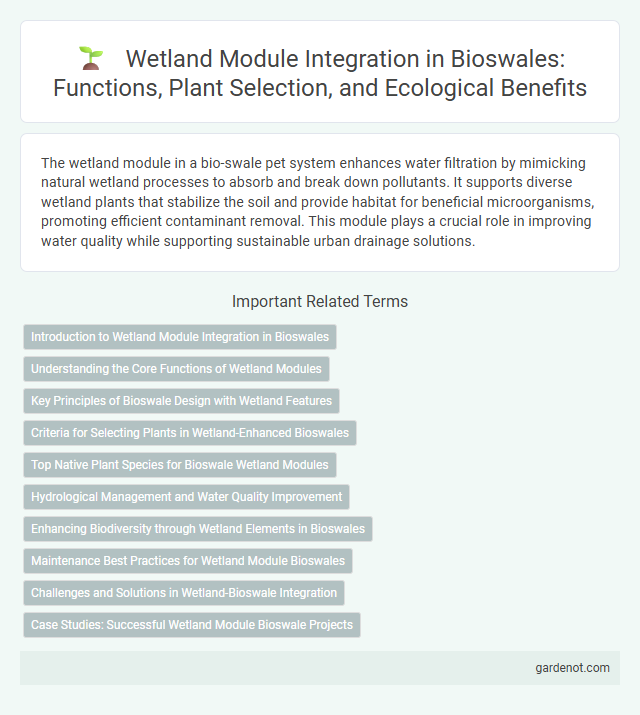The wetland module in a bio-swale pet system enhances water filtration by mimicking natural wetland processes to absorb and break down pollutants. It supports diverse wetland plants that stabilize the soil and provide habitat for beneficial microorganisms, promoting efficient contaminant removal. This module plays a crucial role in improving water quality while supporting sustainable urban drainage solutions.
Introduction to Wetland Module Integration in Bioswales
Wetland module integration in bioswales enhances stormwater management by combining filtration, sedimentation, and absorption processes through native wetland vegetation. This synergy improves pollutant removal efficiency, supports groundwater recharge, and promotes biodiversity. Incorporating wetland modules optimizes water quality improvement while providing crucial habitat within urban green infrastructure.
Understanding the Core Functions of Wetland Modules
Wetland modules in bio-swales play a crucial role in water filtration by utilizing plants and soil microorganisms to remove pollutants such as nitrogen, phosphorus, and heavy metals from stormwater runoff. These modules enhance groundwater recharge and provide habitat for diverse aquatic species, contributing to ecosystem health and resilience. Their core functions include nutrient cycling, sediment capture, and water flow regulation, making them essential components in sustainable urban water management systems.
Key Principles of Bioswale Design with Wetland Features
Bioswale design with wetland features prioritizes natural hydrology restoration, incorporating vegetation that enhances pollutant filtration and sediment capture. Key principles include maximizing surface area for water detention, promoting infiltration through permeable soils, and integrating diverse native plants to optimize nutrient uptake and habitat creation. Strategic grading and flow path design ensure efficient stormwater conveyance while minimizing erosion and supporting groundwater recharge.
Criteria for Selecting Plants in Wetland-Enhanced Bioswales
Selecting plants for wetland-enhanced bioswales requires prioritizing species with high pollutant uptake capabilities, tolerance to saturated soil conditions, and deep root systems for effective soil stabilization. Native wetland plants such as Carex spp., Juncus effusus, and Scirpus spp. are preferred due to their adaptability to fluctuating water levels and ability to enhance nutrient removal through microbial interactions. Plant selection also factors in growth form, seasonal variation in biomass, and resistance to local pests, ensuring sustainable ecological function and improved stormwater treatment efficiency.
Top Native Plant Species for Bioswale Wetland Modules
Top native plant species for bioswale wetland modules include Carex stricta, Juncus effusus, and Asclepias incarnata, known for their exceptional water filtration and erosion control properties. These species thrive in wet, poorly drained soils, enhancing nutrient uptake and providing habitat for pollinators and aquatic wildlife. Incorporating diverse native plants like Lobelia cardinalis and Scirpus cyperinus improves bioswale performance by stabilizing soil and maximizing stormwater infiltration.
Hydrological Management and Water Quality Improvement
The wetland module in bio-swales enhances hydrological management by facilitating natural water infiltration, reducing surface runoff, and promoting groundwater recharge. It improves water quality through sedimentation, nutrient uptake by wetland vegetation, and microbial degradation processes that remove pollutants such as nitrogen, phosphorus, and heavy metals. This natural filtration system helps mitigate stormwater impacts and supports sustainable urban water management.
Enhancing Biodiversity through Wetland Elements in Bioswales
Wetland modules in bioswales significantly enhance biodiversity by creating diverse aquatic habitats that support a wide range of flora and fauna, including amphibians, birds, and invertebrates. Incorporating native wetland plants such as sedges, rushes, and cattails improves water filtration and provides shelter and breeding grounds for wildlife. This biologically rich environment strengthens ecosystem resilience while promoting natural nutrient cycling and water purification.
Maintenance Best Practices for Wetland Module Bioswales
Regular inspection and removal of sediment and debris in wetland module bioswales prevent clogging and ensure optimal water flow. Native wetland vegetation should be monitored and managed to maintain healthy growth and promote pollutant removal. Seasonal maintenance includes checking inlet and outlet structures for blockages and repairing erosion to sustain effective stormwater treatment.
Challenges and Solutions in Wetland-Bioswale Integration
Integrating wetlands with bioswales faces challenges such as fluctuating water levels, sediment accumulation, and nutrient overload that threaten system stability and plant health. Solutions involve designing adaptive water control structures, implementing sediment traps, and selecting native vegetation with high pollutant uptake capacity to enhance water quality and ecosystem resilience. Monitoring nutrient cycling and hydraulic performance ensures the combined system effectively manages stormwater while supporting wetland biodiversity.
Case Studies: Successful Wetland Module Bioswale Projects
Successful wetland module bioswale projects, such as the Arcadia Wetland in California and the Cheonggyecheon Stream restoration in Seoul, demonstrate effective stormwater management and pollutant removal. These projects highlight significant improvements in water quality, flood mitigation, and urban biodiversity enhancement through strategic wetland design and native plant integration. Detailed monitoring data from these sites show reductions in nitrogen, phosphorus, and sediment levels by over 40%, validating the effectiveness of bioswale wetland modules in sustainable urban infrastructure.
Wetland module Infographic

 gardenot.com
gardenot.com